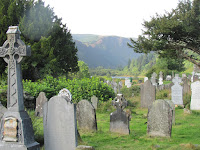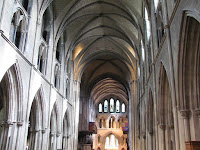The Impact of Christianity…
Just before leaving
Ireland for the remainder of the tour in Great Britain, our group spent two
days in the area around Dublin. The tremendous impact of Saint Patrick, who is
credited with bringing Christianity to Ireland in the fifth century AD, was evident as we visited the awe- inspiring
St. Patrick’s Cathedral. According to tradition, he baptized people in a well
which was on that site. The first church was built there in the fifth century
and after that a number of churches until the present one, constructed in 1370.
It is now the recognized as the National Cathedral of the Church of Ireland and
is the center of worship of a large Anglican congregation.
There are two
symbols widely identified with Ireland which are attributed to Saint Patrick.
One is the shamrock which he supposedly used in order to explain the concept of
the Trinity to his followers. The other is the Celtic cross—a cross
superimposed on a round disk, the sun. According to one interpretation, it
represented the transition of people from sun worship to the worship of God’s
Son and the acceptance Jesus Christ as Lord and Savior.
It was interesting
to see the campus of Trinity College in session as we walked to the library and
went through the exhibit of the Book of Kells, a beautifully illustrated,
handwritten manuscript by 9th century monks. This treasured book contains the
four gospels painstakingly copied in Latin, for the purpose of educating people
and “turning darkness into light,” as one monk described it.
 |
| Tower at Gledalough |
Our final
excursion before departing to Wales was to Glendalough, a peaceful Catholic
retreat center and monastic village which began with St. Kevin around 690 AD.
Two very impressive cylindrical stone towers with conical roofs and the ruins
of several ancient churches laid scattered through the countryside between two
lakes, testament to the village which thrived there for centuries. Glendalough
is still used today as a place of study and meditation for people around the
world.
From Dublin, our
group boarded a ferry boat to Holyhead, Wales, about an hour ride across the
Irish Sea. On the way, Al and I talked to a young man from Ireland who was
immigrating to the United States, like millions of Irish in centuries past. He
was going to spend a year as an intern at an Irish Cultural Arts Center in New
York. First, though, he was going to visit friends in London to watch a highly
charged Rugby match between Wales and England.
He was very
friendly, informing me that my Irish-English ancestors were definitely
Protestant! I was surprised that he got it right; however, according to him,
the Irish can tell Protestants from Catholics by their names. Hmmm, food for
thought!
Once in Wales, we
were met by a new bus driver and were transported through green countryside
reminiscent of Ireland, to the impressive Conwy Castle. By this time, Al was
getting tired of castles, but still hung in there as we explored the castle
grounds, walked on a portion of the high stone wall and climbed to the top of
one of the eight tall towers where there was a great view of the Conwy River.
King Edward I had it built in five years, from 1283-1287, an amazing
accomplishment without modern equipment and engineering.
When thinking
about the impact of Christianity from the past to the present in Ireland and
Great Britain, I am reminded of the great impact it has had upon my own life.
Knowing Christ personally and believing that His love for me is “wholehearted,
constant and unconditional” has given me joy, peace, purpose in this life and
confidence in the life yet to come. (“The Heart of Revival,” Nicky Gumble p.
62) How thankful I am for that!
“But God demonstrates his own love for us in this: While we
were still sinners, Christ died for us.” Romans 5:8 NIV
 |
| Book of Kells |
 |
| Ancient Celtic Crosses in graveyard at Glendalough |

.jpg)

Comments
Post a Comment